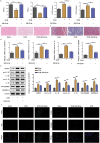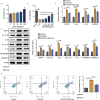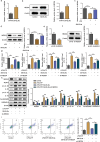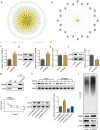Salvia miltiorrhiza-derived exosome-like nanoparticles improve diabetic cardiomyopathy by inhibiting NLRP3 inflammasome-mediated macrophage pyroptosis via targeting the NEDD4/SGK1 axis
- PMID: 40391625
- PMCID: PMC12143680
- DOI: 10.1080/17435889.2025.2506351
Salvia miltiorrhiza-derived exosome-like nanoparticles improve diabetic cardiomyopathy by inhibiting NLRP3 inflammasome-mediated macrophage pyroptosis via targeting the NEDD4/SGK1 axis
Abstract
Aim: Exosome-like nanoparticles mediate intercellular communication and regulate gene expression. In this study, we isolated and purified exosome-like nanoparticles from Salvia miltiorrhiza (SM-ELNs), a traditional Chinese medicinal herb, and investigated their therapeutic effects on diabetic cardiomyopathy (DCM).
Materials & methods: To investigate the effect of SM-ELNs on DCM, we established a mouse model via HFD/STZ treatment. Cardiac function was assessed by echocardiography. Cardiac hypertrophy was assessed by measuring the heart weight/body weight ratio and HE staining, while myocardial fibrosis was evaluated using Masson's trichrome staining. The role of SM-ELNs on NLRP3 inflammasome inhibition and macrophage pyroptosis were evaluated both in vivo and in vitro. The interaction between NEDD4 and SGK1 was analyzed by Co-IP and ubiquitination assays.
Results: SM-ELNs treatment alleviated cardiac function and histopathological changes in DCM mice. Moreover, SM-ELNs suppressed NLRP3 inflammasome activation and subsequent macrophage pyroptosis in both in vivo and in vitro models. Mechanistically, NEDD4 facilitated the ubiquitination and degradation of SGK1 in macrophages. Both NEDD4 depletion and SGK1 addition could counteract the SM-ELNs-induced suppression of NLRP3 inflammasome-triggered macrophage pyroptosis in LPS/ATP-treated RAW264.7 cells.
Conclusion: Our study provides the first evidence that SM-ELNs inhibit NLRP3 inflammasome-mediated macrophage pyroptosis in DCM by modulating the NEDD4/SGK1 axis.
Keywords: NEDD4; NLRP3; SGK1; SM-ELNs; inflammasome; macrophage; pyroptosis.
Conflict of interest statement
The authors have no relevant affiliations or financial involvement with any organization or entity with a financial interest in or financial conflict with the subject matter or materials discussed in the manuscript. This includes employment, consultancies, honoraria, stock ownership or options, expert testimony, grants or patents received or pending, or royalties.
No writing assistance was utilized in the production of this manuscript.
Figures





Similar articles
-
piR112710 attenuates diabetic cardiomyopathy through inhibiting Txnip/NLRP3-mediated pyroptosis in db/db mice.Cell Signal. 2024 Oct;122:111333. doi: 10.1016/j.cellsig.2024.111333. Epub 2024 Aug 3. Cell Signal. 2024. PMID: 39102928
-
Vitamin D improves diabetic cardiomyopathy by inhibiting pyroptosis through the NOX4/NLRP3 inflammasome pathway.Food Funct. 2025 Aug 11;16(16):6718-6732. doi: 10.1039/d5fo00717h. Food Funct. 2025. PMID: 40748236
-
Maiwei Yangfei decoction protects against pulmonary fibrosis by suppressing NLRP3 inflammasome-mediated pyroptosis of alveolar macrophage.Phytomedicine. 2025 Sep;145:157041. doi: 10.1016/j.phymed.2025.157041. Epub 2025 Jul 5. Phytomedicine. 2025. PMID: 40652799
-
New Insights on the Potential Role of Pyroptosis in Parkinson's Neuropathology and Therapeutic Targeting of NLRP3 Inflammasome with Recent Advances in Nanoparticle-Based miRNA Therapeutics.Mol Neurobiol. 2025 Jul;62(7):9365-9384. doi: 10.1007/s12035-025-04818-4. Epub 2025 Mar 18. Mol Neurobiol. 2025. PMID: 40100493 Review.
-
NLRP3 Inflammasome-Mediated Pyroptosis in Osteoporosis: Osteoimmune Mechanisms and Therapeutic Targeting.J Cell Mol Med. 2025 Aug;29(16):e70798. doi: 10.1111/jcmm.70798. J Cell Mol Med. 2025. PMID: 40853781 Free PMC article. Review.
References
Publication types
MeSH terms
Substances
LinkOut - more resources
Full Text Sources
Other Literature Sources
Medical
